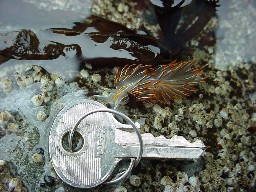Key to Suborder Cladobranchia Superfamily Aeolidacea
Phylum MolluscaClass Gastropoda
Subclass Opisthobranchia
Order Nudibranchia
Taken primarily from Kozloff, 1987, 1996 p. 255 (Copyright 1987, 1996, University of Washington Press. Used in this web page by permission of University of Washington Press)
| Jump to: | ||||
| Lower taxonomic level | Main Page | Alphabetic Index | Systematic Index | Glossary |
| 1a | Each ceras with a sail-like ridge on its posterior side (the ridge begins near the base and runs for much of the length of the ceras) (length up to 2 cm) | Fiona pinnata |
| 1b | Cerata without a sail-like ridge on the posterior side | 2 |
| 2a | At least a few rows of cerata located anterior to the bases of the rhinophores | 3 |
| 2b | None of the rows of cerata located anterior to the bases of the rhinophores (some may be at the same level as the rhinophores, however) | 7 |
| 3a | Longest cerata more than half the length of the body; cerata usually oriented approximately at right angles to the anterior-posterior axis of the body; foot proportionately broad (usually less than 3 times as long as wide), tapering to a point at the tail | Cumanotus beaumonti |
| 3b | Longest cerata less than one-third the length of the body; cerata usually oriented approximately parallel to the anterior-posterior axis of the body; foot relatively narrow (usually more than 4 times as long as wide), bluntly rounded at the tail | 4 |
| 4a | Anterolateral corners of foot projecting as acute pedal (oral) tentacles (photo); body covered with gray to brown spots, these being most dense on the cerata (some specimens, especially from floats, lack pigment); usually with a prominent triangular white patch just anterior to the rhinophores (photo); hepatic diverticula not clearly visible within the cerata of pigmented specimens; usually associated with anemones, especially Metridium and Anthopleura; length often attaining 5 cm. (Aeolidia papillosa in the original key) | 20 |
| 4b | ||
| 5a | ||
| 5b | ||
| 6a | ||
| 6b | ||
| 7a | Anterolateral corners of foot elongated, forming rather prominent tentacles | 8 |
| 7b | Anterolateral corners of foot broadly rounded or somewhat triangular, but not forming prominent tentacles | 13 |
| 8a | Basic body color purple; rhinophores and cerata bright orange for their entire length (Flabellina iodinea in original key) | Flabellinopsis iodinea |
| 8b | Basic body color not purple, usually translucent white or grayish; rhinophores and cerata not orange for their entire length (they may, however, be partly orange) | 9 |
| 9a | With an orange band beginning just anterior to the rhinophores
and passing between them, reaching the first group of cerata
(a similar orange band may be present on the cardiac region); orange areas
usually bordered by broad, opaque white or luminous blue dorsomedial lines
that begin on the oral tentacles
and continue to the tip of the tail; tips of cerata
usually orange or chrome yellow, but with some white at the extremity.
(All nudibranchs with this description were called Hermissenda
crassicornis in the Kozloff key)
 |
19 |
| 9b | Without orange bands on the dorsum; white lines on the dorsum, if present, narrow and often interrupted; tips of cerata may be opaque white, but rarely orange | 10 |
| 10a | ||
| 10b | ||
| 11a | ||
| 11b | ||
| 12a | ||
| 12b | ||
| 13a | ||
| 13b | ||
| 14a | ||
| 14b | ||
| 15a | ||
| 15b | ||
| 16a | ||
| 16b | ||
| 17a | ||
| 17b | ||
| 18a | ||
| 18b | ||
| 19a | With a longitudinal white line running from the base to near the tip of the anterior side of each ceras. Found from Point Reyes, CA through Alaska | Hermissenda crassicornis |
| 19b | Without a longitudinal white line running from the base to near the tip of the anterior side of each ceras. Found from Bodega Bay, CA south to the Sea of Cortez | Hermissenda opalescens |
| 20a | Rhinophores smooth | Aeolidia papillosa |
| 20b | Rhinophores warty (may become smooth after preservation), cerata broader at the base, may be bristly | Aeolidia loui |
Taxonomic Levels Represented in this Key:
Aeolidia loui
Hermissenda crassicornis
Hermissenda
opalescens
Page created by Robbie Wheeling, 7-2002
Edited by Hans Helmstetler 1-2003, Dave Cowles 2005-